java/stream
2.1 接口说明

/** * A sequence of elements[元素的序列] supporting sequential【串形】 and parallel【并行】 aggregate * operations【聚合操作】. The following example【如下的示例】 illustrates【说明】 an aggregate operation using * {@link Stream} and {@link IntStream}: * * <pre>{@code * int sum = widgets.stream() * .filter(w -> w.getColor() == RED) * .mapToInt(w -> w.getWeight()) * .sum(); * }</pre> * * In this example, {@code widgets} is a {@code Collection<Widget>}. We create * a stream of {@code Widget} objects via {@link Collection#stream Collection.stream()}, * filter it to produce【生成】 a stream containing only the red widgets, and then * transform it into a stream of {@code int} values representing the weight of * each red widget. Then this stream is summed【被累加】 to produce a total weight. * * <p>In addition to【除了】 {@code Stream}, which is a stream of object references, * there are primitive specializations【原始特殊化】 for {@link IntStream}, {@link LongStream}, * and {@link DoubleStream}, all of which are referred to as "streams" and * conform to the characteristics and restrictions【特征和限制】 described here. * * <p>To perform【执行】 a computation, stream * <a href="package-summary.html#StreamOps">operations</a> are composed into a * <em>stream pipeline</em>. A stream pipeline consists of【由..组成】 a source (which * might be an array, a collection, a generator function【生成器函数】, an I/O channel, * etc), zero or more <em>intermediate operations【中间操作】</em> (which transform a * stream into another stream, such as {@link Stream#filter(Predicate)}), and a * <em>terminal operation</em> (which produces a result or side-effect【副作用】, such * as {@link Stream#count()} or {@link Stream#forEach(Consumer)}). * Streams are lazy; computation on the source data is only performed when the * terminal operation is initiated, and source elements are consumed only * as needed. * * <p>Collections and streams, while bearing some superficial similarities, * have different goals. Collections are primarily concerned with the efficient * management of, and access to, their elements. By contrast, streams do not * provide a means to directly access or manipulate their elements, and are * instead concerned with declaratively describing their source and the * computational operations which will be performed in aggregate on that source. * However, if the provided stream operations do not offer the desired * functionality, the {@link #iterator()} and {@link #spliterator()} operations * can be used to perform a controlled traversal. * * <p>A stream pipeline, like the "widgets" example above, can be viewed as * a <em>query</em> on the stream source. Unless the source was explicitly * designed for concurrent modification (such as a {@link ConcurrentHashMap}), * unpredictable or erroneous behavior may result from modifying the stream * source while it is being queried. * * <p>Most stream operations accept parameters that describe user-specified * behavior, such as the lambda expression {@code w -> w.getWeight()} passed to * {@code mapToInt} in the example above. To preserve correct behavior, * these <em>behavioral parameters</em>: * <ul> * <li>must be <a href="package-summary.html#NonInterference">non-interfering</a> * (they do not modify the stream source); and</li> * <li>in most cases must be <a href="package-summary.html#Statelessness">stateless</a> * (their result should not depend on any state that might change during execution * of the stream pipeline).</li> * </ul> * * <p>Such parameters are always instances of a * <a href="../function/package-summary.html">functional interface</a> such * as {@link java.util.function.Function}, and are often lambda expressions or * method references. Unless otherwise specified these parameters must be * <em>non-null</em>. * * <p>A stream should be operated on (invoking an intermediate or terminal stream * operation) only once. This rules out, for example, "forked" streams, where * the same source feeds two or more pipelines, or multiple traversals of the * same stream. A stream implementation may throw {@link IllegalStateException} * if it detects that the stream is being reused. However, since some stream * operations may return their receiver rather than a new stream object, it may * not be possible to detect reuse in all cases. * * <p>Streams have a {@link #close()} method and implement {@link AutoCloseable}, * but nearly all stream instances do not actually need to be closed after use. * Generally, only streams whose source is an IO channel (such as those returned * by {@link Files#lines(Path, Charset)}) will require closing. Most streams * are backed by collections, arrays, or generating functions, which require no * special resource management. (If a stream does require closing, it can be * declared as a resource in a {@code try}-with-resources statement.) * * <p>Stream pipelines may execute either sequentially or in * <a href="package-summary.html#Parallelism">parallel</a>. This * execution mode is a property of the stream. Streams are created * with an initial choice of sequential or parallel execution. (For example, * {@link Collection#stream() Collection.stream()} creates a sequential stream, * and {@link Collection#parallelStream() Collection.parallelStream()} creates * a parallel one.) This choice of execution mode may be modified by the * {@link #sequential()} or {@link #parallel()} methods, and may be queried with * the {@link #isParallel()} method. * * @param <T> the type of the stream elements * @since 1.8 * @see IntStream * @see LongStream * @see DoubleStream * @see <a href="package-summary.html">java.util.stream</a> */
2.1 Stream初始化
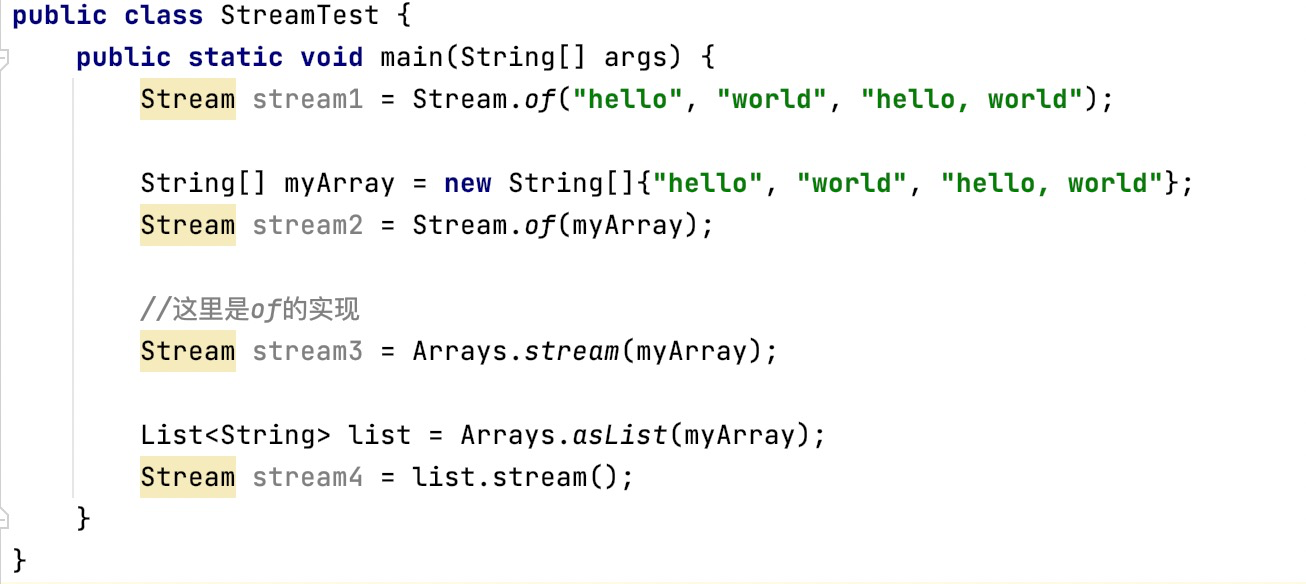
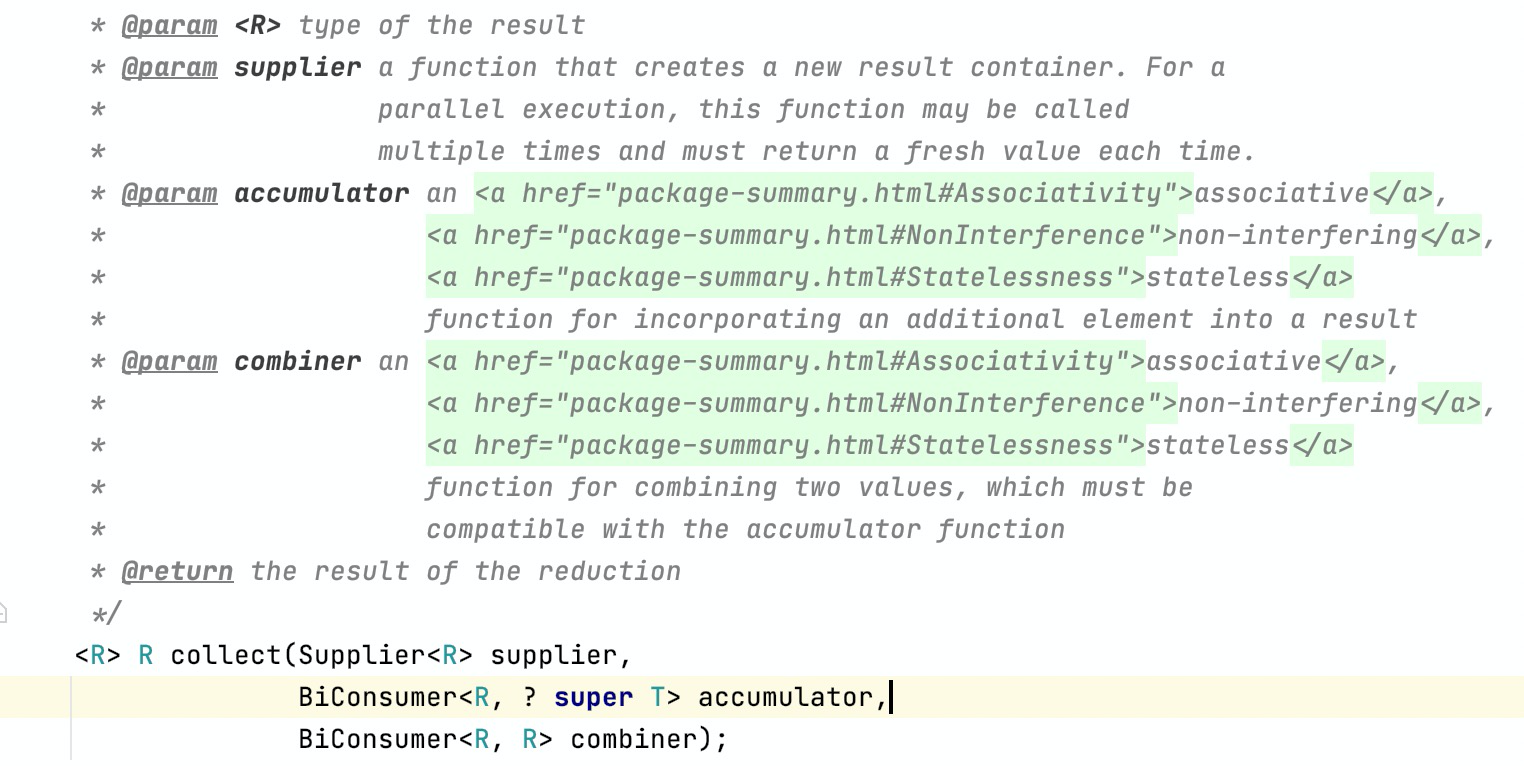
![]()
/** * Performs【执行】 a <a href="package-summary.html#MutableReduction">mutable * reduction</a> operation【可变的精简/汇聚的操作】 on the elements of this stream. A mutable * reduction is one in which the reduced value is a mutable result container, * such as an {@code ArrayList}, and elements are incorporated by updating * the state of the result rather than by replacing the result. This * produces a result equivalent to: * <pre>{@code * R result = supplier.get(); * for (T element : this stream) * accumulator.accept(result, element); * return result; * }</pre> * * <p>Like {@link #reduce(Object, BinaryOperator)}, {@code collect} operations * can be parallelized【并行】 without requiring additional synchronization【无需额外的同步】. * * <p>This is a <a href="package-summary.html#StreamOps">terminal * operation</a>. * * @apiNote There are many existing classes in the JDK【JDK中有许多存在的类】 whose signatures are * well-suited【非常适合】 for use with method references as arguments to {@code collect()}. * For example, the following will accumulate strings【如下汇聚字符串】 into an {@code ArrayList}: * <pre>{@code * List<String> asList = stringStream.collect(ArrayList::new, ArrayList::add, * ArrayList::addAll); * }</pre> * * <p>The following will take a stream of strings and concatenates【连接】 them into a * single string: * <pre>{@code * String concat = stringStream.collect(StringBuilder::new, StringBuilder::append, * StringBuilder::append) * .toString(); * }</pre> * * @param <R> type of the result * @param supplier a function that creates a new result container. For a * parallel execution, this function may be called * multiple times and must return a fresh value each time. * @param accumulator an <a href="package-summary.html#Associativity">associative</a>, * <a href="package-summary.html#NonInterference">non-interfering</a>, * <a href="package-summary.html#Statelessness">stateless</a> * function for incorporating an additional element into a result * @param combiner an <a href="package-summary.html#Associativity">associative</a>, * <a href="package-summary.html#NonInterference">non-interfering</a>, * <a href="package-summary.html#Statelessness">stateless</a> * function for combining two values, which must be * compatible with the accumulator function * @return the result of the reduction */
Stream<Integer> limit = Stream.iterate(1, item -> item + 2).limit(6);
分析:
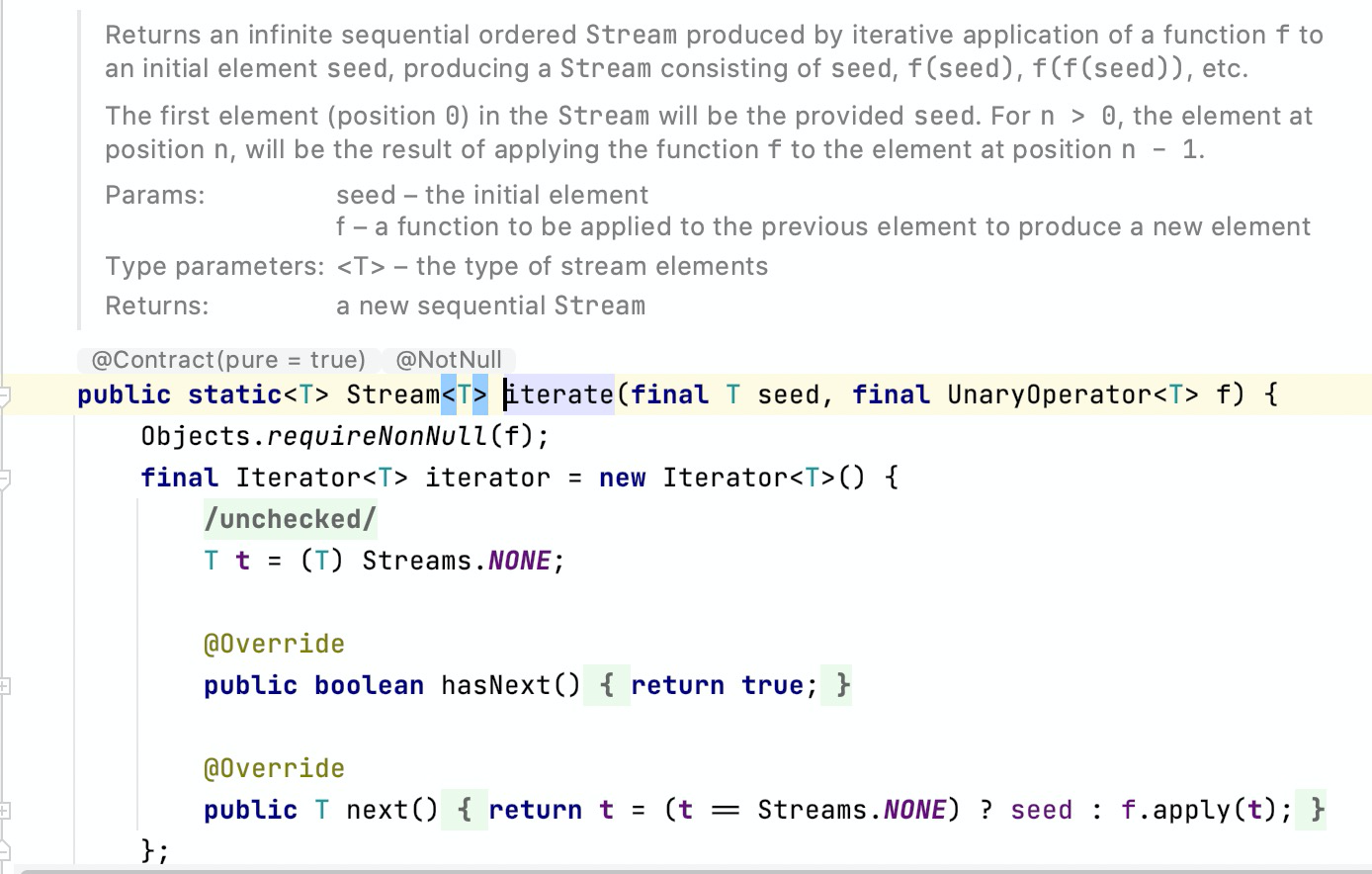
/** * Returns an infinite sequential ordered【无限串形有序】 {@code Stream} produced by iterative * application of a function {@code f} to an initial element {@code seed}, * producing a {@code Stream} consisting of {@code seed}, {@code f(seed)}, * {@code f(f(seed))}, etc. * * <p>The first element (position {@code 0}) in the {@code Stream} will be * the provided {@code seed}. For {@code n > 0}, the element at position * {@code n}, will be the result of applying the function {@code f} to the * element at position {@code n - 1}. * * @param <T> the type of stream elements * @param seed the initial element * @param f a function to be applied to the previous element to produce * a new element * @return a new sequential {@code Stream} */
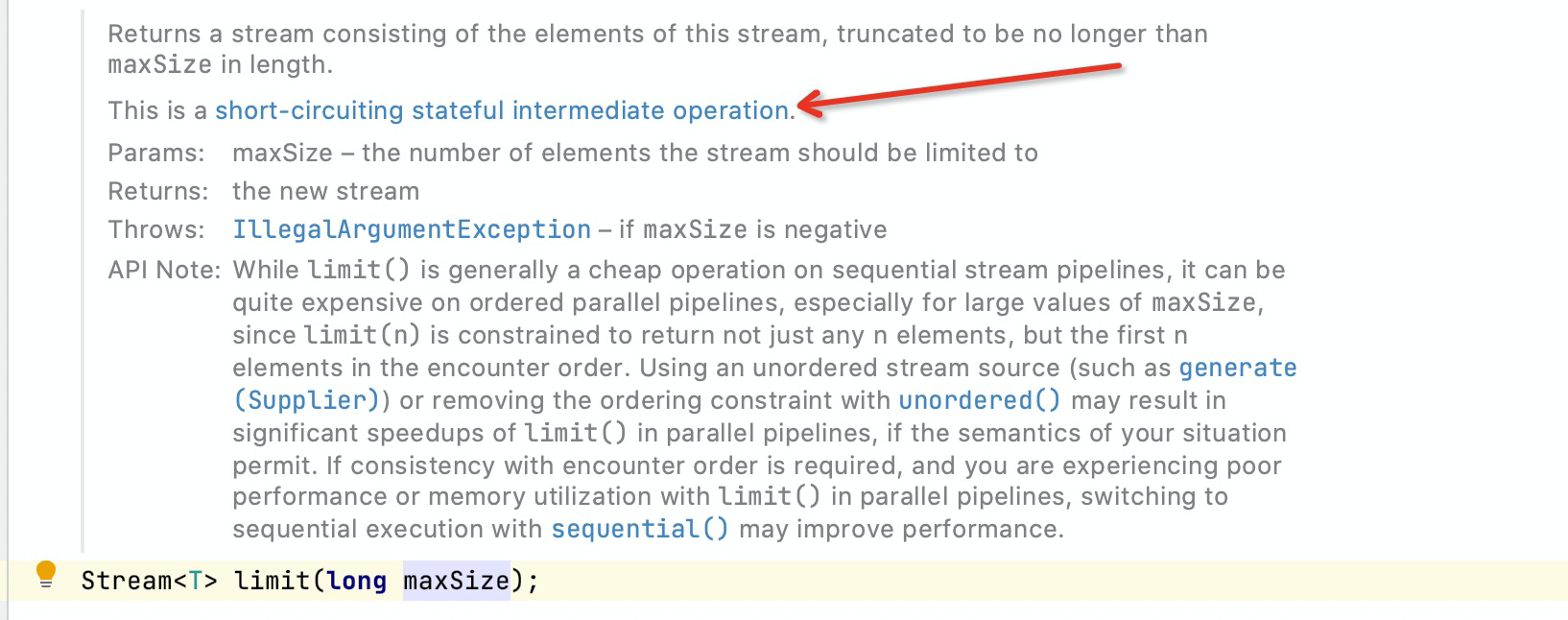
描述性语言。内部迭代【操作的是流】流关注的是对数据的计算。
流与迭代器类似的一点是:流是无法重复使用或者消费的。
外部迭代的区别【操作的是元素,一个个从集合里面取出来】集合关注的是数据与数据存储本身。
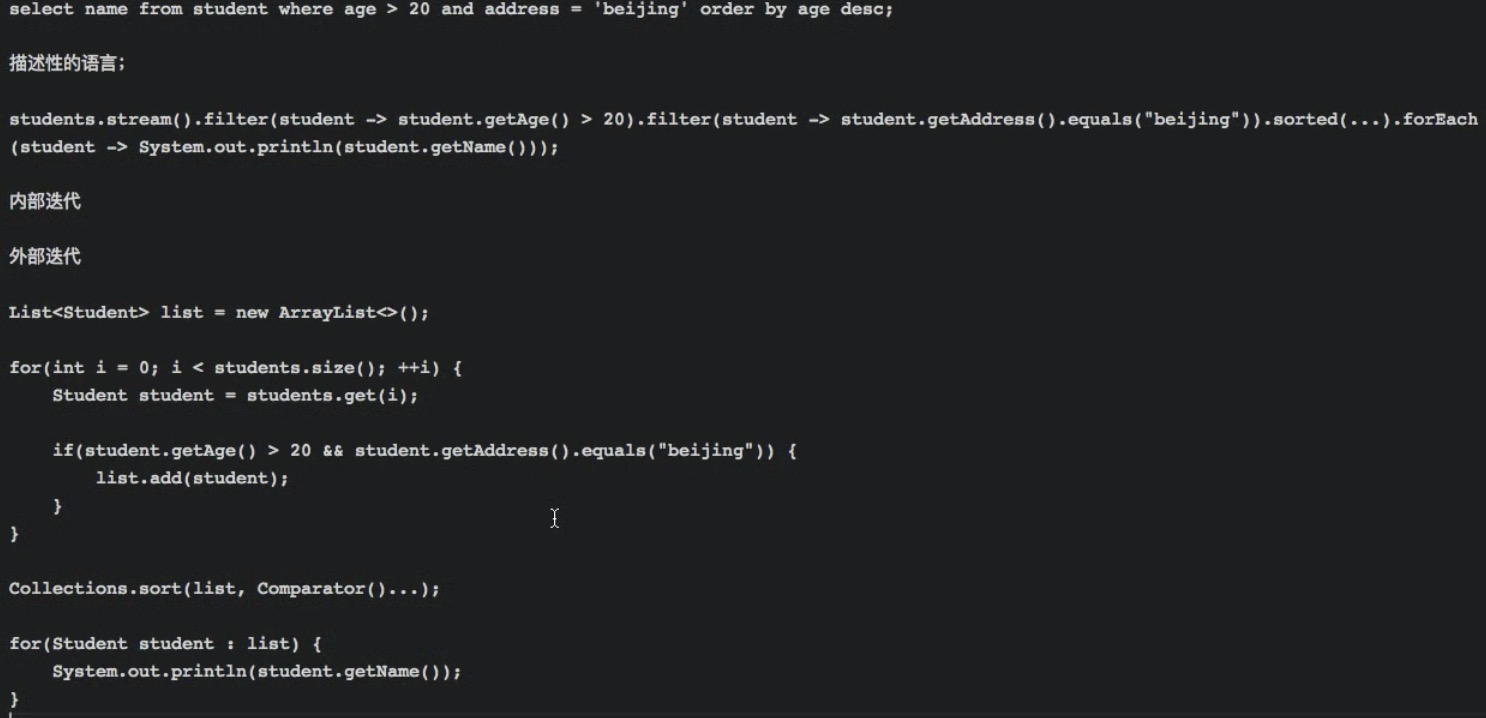
懵懵懂懂,难得糊涂!
潜心所向,无关风月!


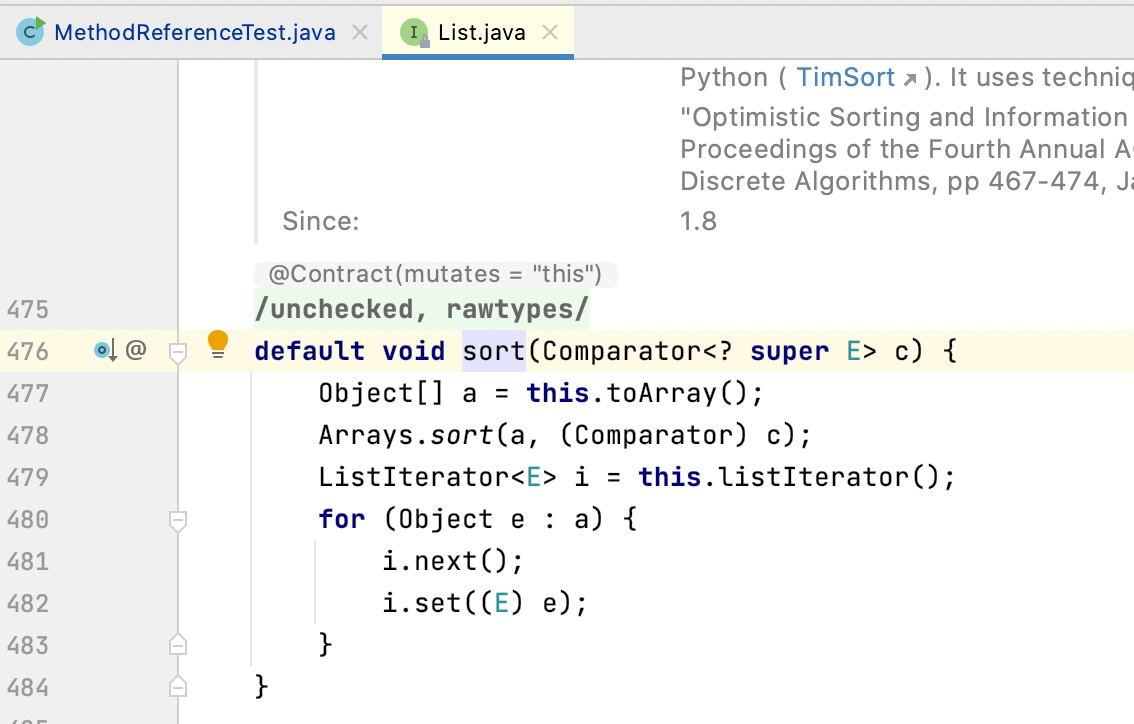
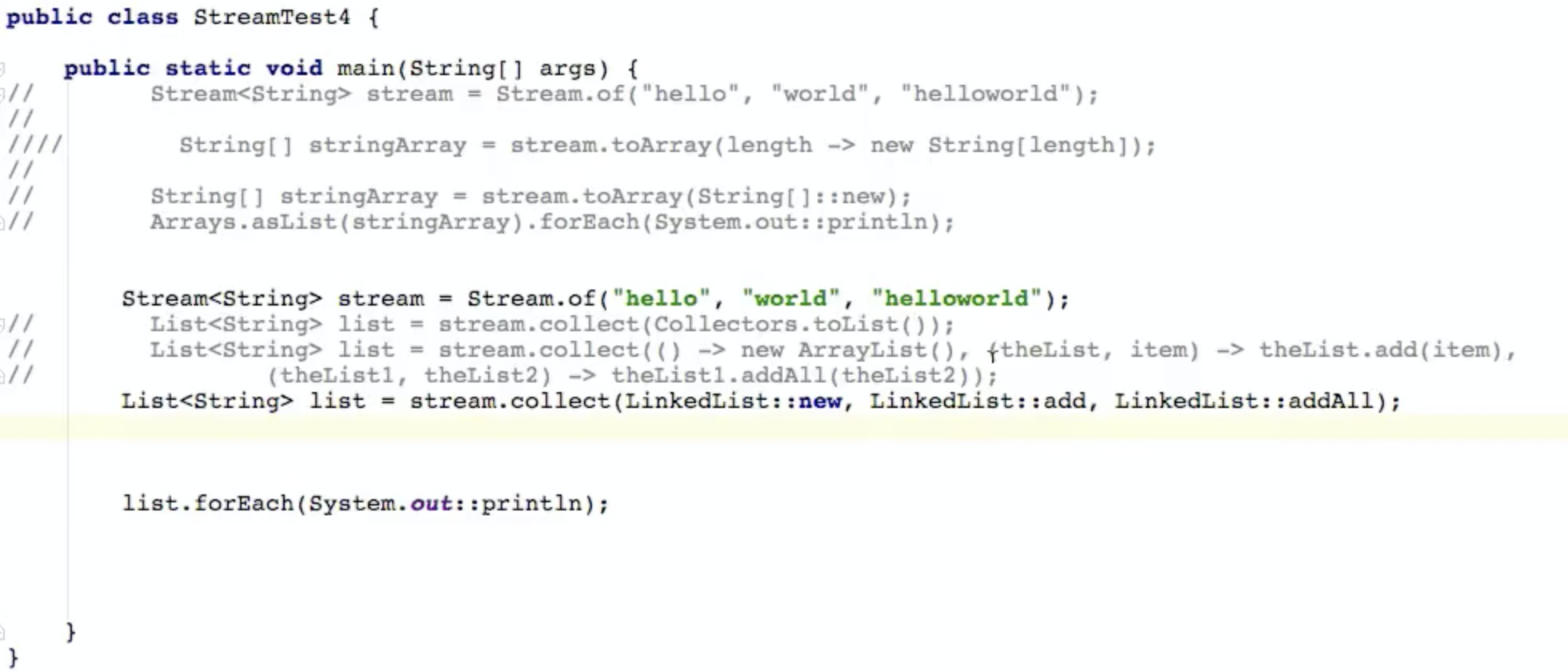
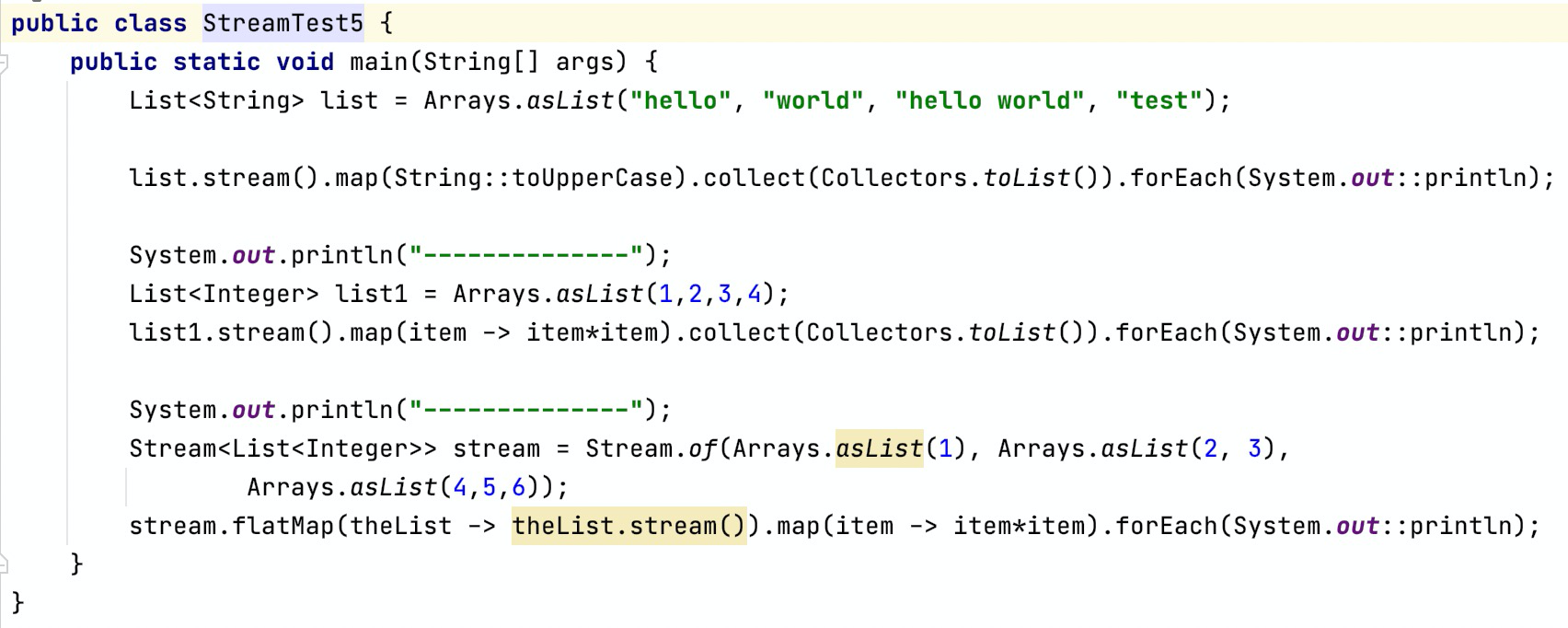



 浙公网安备 33010602011771号
浙公网安备 33010602011771号